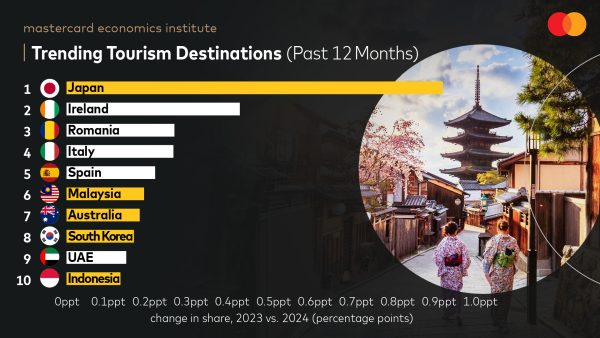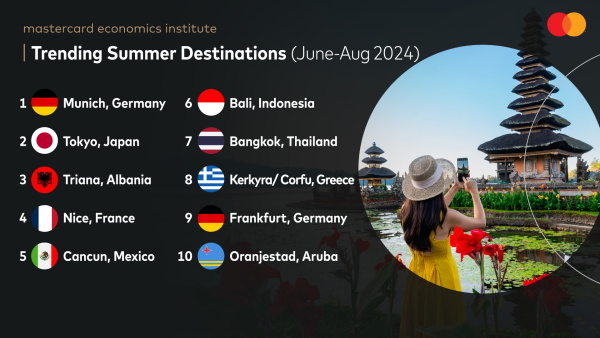SINGAPORE 20 May 2024: The global travel sector is breaking boundaries in 2024 as consumer spending on tourism remains robust and passenger traffic soars, according to the latest report from the Mastercard Economics Institute (MEI).
Released last week, MEI’s fifth annual report, “Travel Trends 2024: Breaking Boundaries,” provides comprehensive insights into the evolving landscape of the travel industry across 74 markets, including 13[1] in the Asia Pacific region (APAC).
Despite fluctuating exchange rates and varying levels of affordability, travel is booming. Nine out of the last 10 record-setting spending days in the global cruise and airline industries occurred this year. Looking ahead, the MEI anticipates this momentum will continue as consumers worldwide prioritise meaningful experiences and allocate more of their budgets to travel.

Here in the Asia Pacific region, a few themes stand out
Japan emerged as the top trending destination worldwide (growing 0.9% vs Ireland at 0.4%), as it welcomed 3,081,600 visitors from abroad in March 2024 — the highest level ever — even before the peak travel season began. Driven by a weak yen (the lowest since 1990), Japan’s favourable exchange rate is expected to help it remain the clear tourism frontrunner throughout 2024, benefitting Japanese businesses catering to tourists and the local economy overall.
APAC passenger traffic is rebounding, particularly for shorter, intra-regional trips. For example, this summer, Bangkok, Kuala Lumpur, and Perth are the top destinations for travellers from Singapore.
According to MEI, Thailand’s tourism is expected to fully recover in 2024, with total visitor arrivals now only 7% below 2019 pre-pandemic levels[3]. Notably, inbound flight traffic from South Asia and the ASEAN region is nearly 20% above 2019.

Chinese Mainland Tourism Rebounds
The Chinese mainland’s travel dynamic has shifted, as more Chinese tourists are prioritising domestic trips over international ones.
The Chinese mainland’s domestic tourism story is positive, as air passenger traffic has fully normalised and even exceeded 2019 levels, benefiting local businesses. Meanwhile, international tourism traffic leaving the Chinese Mainland continues to recover and is now at 80.3% of 2019 levels.
Additional upside growth is expected in 2024, supported by visa exemptions in APAC and beyond and an increase in international flight capacity, which will benefit destinations such as Singapore, Malaysia, and Thailand.
More Indians are travelling
Strengthened by a burgeoning middle class, additional route capacity, and a strong desire to travel, 2024 marks when more Indians travel internationally than at any time in history.
In the first three months of 2024, 97 million passengers travelled through Indian airports. Just 10 years ago, the same figure would have taken a whole year to achieve. As of March 2024, domestic passenger traffic is up 21% compared to 2019 levels, while international passenger traffic is up 4%.
Indian travellers to key markets are up significantly in 2024 compared to 2019: 53% increase in visitors to Japan, 248% increase to Vietnam, 59% increase to the United States (notable as total overseas arrivals to the U.S. are still 7% below 2019 levels, largely due to the strong USD).
Leisure for Longer
In APAC (excluding ANZ) in 2024, tourists extend their trips by an average of 1.2 days to 7.4 days, motivated by the affordability of destinations, warm weather, and favourable exchange rates. This compares to the 2019 average of 6.1 days per trip.
In Australia and New Zealand (ANZ), overseas visitors stay for an average of 5.4 days, an increase of 0.6 days compared to 2019.
The APAC destinations with the longest increase in trip duration between 2019-2024 are India (+2 days), Vietnam (+2 days), Indonesia (+1.9 days), and Japan (+1.4 days), largely due to their lower growth in hotel prices during this period compared to other markets.
Longer stays generally translate to more spending per trip, which benefits local economies.
Thrill Seekers Want Experiences and Nightlife
Consumers globally continue to prioritise experiences over material goods. This is playing out in the travel sector as spending on experiences and nightlife totals 12% of tourism sales – the highest point in at least five years. Meanwhile, retail shopping is recovering at a slower pace.
Australian tourists are the highest spenders globally on experiences and nightlife
In 2024, Aussies will spend one out of every five dollars (19%) on these activities, significantly higher than the global average (12%). Tourists from the Chinese Mainland are also increasingly seeking out experiences, spending 10% on this category in 2024, up from 7% in 2023.
Explore the full Travel 2024: Breaking Boundaries report here. Additional reports and insights from the Mastercard Economics Institute can be found here






